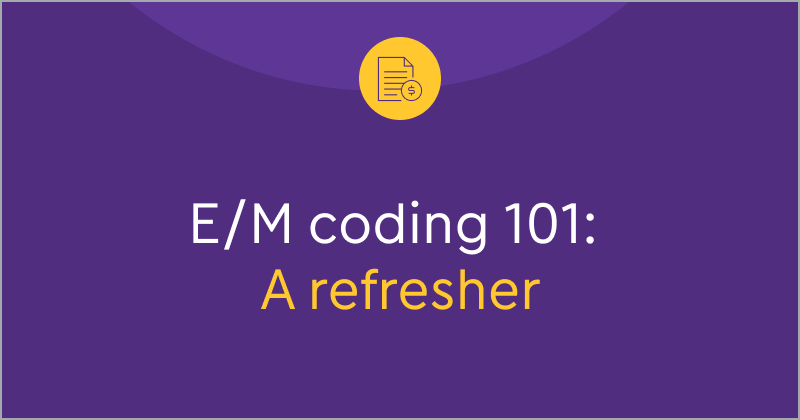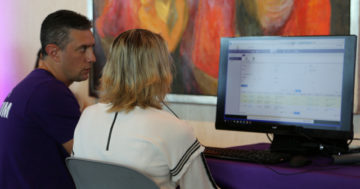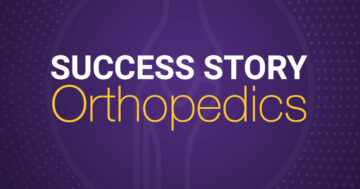The Current E/M Coding Landscape: Key Updates to Be Aware Of

Importance of keeping up with E/M code guidelines and updates
By staying current with the evolving landscape of E/M codes, clinicians may be able to avoid claim denials and unnecessary payment delays. This overview highlights important information that impacts how E/M visits are coded.
E/M coding before 2021
E/M coding changes in 2021 represented a significant overhaul. Before those changes were implemented, many clinicians expressed frustration that they were investing significant effort to treat their patients — documenting the exam, ordering tests, reviewing results and making referrals — but felt that the coding and subsequent reimbursement did not adequately reflect the work or time involved in providing the care.
As of 2023, providers in both inpatient and outpatient settings can bill according to the appropriate evaluation level based on medical decision-making (MDM) or the total time spent evaluating and managing the patient’s condition on the same day. This total time might include activities such as making calls, reviewing relevant records or contacting other providers, not just face-to-face interactions with the patient.
Levels of medical decision-making
Taking a closer look at the four levels of MDM — straightforward, low, moderate and high — is essential. These levels are determined by three elements:
- Number and complexity of problems addressed at the encounter
- Amount and/or complexity of data reviewed and analyzed
- Risk of complications and/or morbidity or mortality of patient management
Two of the three elements must be met or exceeded to qualify for a particular level of MDM. The provider’s role and responsibility can also impact MDM since specific activities, such as interpreting data or discussing management with other providers, count toward the E/M service level.
Time requirements
When choosing to bill by time, there are specific time components for different levels of new patient visits: Level 2 requires 15 minutes, Level 3 requires 30 minutes, Level 4 demands 45 minutes, and Level 5 is for visits that are 60 minutes. For established patients, the time components are slightly shorter, ranging from 10 minutes for Level 2 to 40 minutes for Level 5.
When billing by time, providers can indicate the total time spent on patient care without detailing every task performed, thereby potentially simplifying the documentation process.
If a visit takes longer than usual, a clinician might choose to bill based on time rather than medical decision-making. For example, a counseling session with a patient might take longer, even if the medical decision-making is not as complex. Billing based on time might be appropriate in certain situations, such as counseling patients who are non-compliant or conducting extensive reviews of medical histories.
Bottom line
- Clinicians can choose to code E/M visits based on time or level of medical decision-making
- Both outpatient and inpatient E/M visits have adopted this coding approach
“New E/M guidelines allow my documentation to be much easier because I can narrate what I think is important rather than making sure I hit every documentation requirement that may or may not pertain to the problem that the patient came to see me for.”
Dr. Suezie Kim, Medical Director, ModMed
Changes to telehealth E/M coding in 2025
For 2025, the American Medical Association (AMA) released new telehealth E/M codes, specifically highlighting the new patient synchronous audio-video visit code (98000) for straightforward medical decision-making that lasts about 15 minutes. Medicare recognizes the virtual check-in code (98016) for telehealth visits where the patient is at a non-originating site. This CPT code replaced an earlier G2012 code that allowed billing for brief communications unrelated to a recent or upcoming visit.
Virtual check-ins enable a doctor to bill for short discussions with patients at non-originating sites that don’t equate to a full telehealth visit, as long as certain criteria are met. For instance, discussing recent blood pressure readings can qualify as a virtual check-in under this code, provided it does not relate to a previous E/M service within the last seven days and does not necessitate an E/M visit in the next 24 hours. These virtual check-ins from non-originating sites can take place via various virtual channels, including phone calls, as long as they meet the established criteria.
Bottom line
- Medicare recognizes the virtual check-in code 98016 for telehealth visits
- Verify which insurance providers accept other new codes for telehealth services
- Keep patients informed about which telehealth services are covered or not covered
Implementing payer-specific scrub rules
Billers can implement a scrub edit, which is particularly useful when a specific payer does not recognize certain new telehealth codes. The scrub edit process occurs after the doctor’s visit is documented and finalized. Even if a practitioner uses a new telehealth code, that visit could be flagged for review through a scrub rule so the biller can assign a code recognized by the payer in question. Scrub edits can check for payer-specific requirements, such as whether to use special modifiers for telehealth visits.
Bottom line
- Scrub edits can check for payer-specific requirements, including necessary modifiers for telehealth visits
- Depending on your billing system, you can configure different scrub rules to flag claims or codes that could benefit from additional review
- With scrub rules, billers have a chance to assign a payer-recognized code for a claim before submission
How ModMed supports E/M coding
“It’s very hard to keep up with all the changes that happen,” says Dr. Kim, “and the utility of having an EHR to help us with that is enormous.”
When providing services at your practice, you can rest assured that prompts suggested by ModMed® specialty-specific EHRs, EMA® and gGastro®, reflect current national coding guidelines. Our EHRs also allow the provider to choose whether to bill based on time or MDM. Selections are always editable, allowing clinicians and billers to review, approve or change coding.
Bottom line
- Communicate relevant coding information to clinicians prior to appointments
- Provide decision-making resources and tools for billing and clinical staff
- Leverage proper preparation and communication to help reduce claim denials
Explore the AMA’s table of Levels of Medical Decision Making.
This blog is intended for informational purposes only and does not constitute legal, compliance or medical advice. The rules and information discussed in this blog are subject to change, and ModMed does not make any representations or guarantees regarding accuracy. Please consult with your legal counsel and other qualified advisors to ensure compliance with applicable laws, regulations, and standards.







